
Wine Culture and Information since 2002 - Volume 22
 Wine Culture and Information since 2002 - Volume 22 |
|
Issue 136, January 2015 |
Contents |
|
|
The Law is the Law |
|
I am borrowing the final cue of the movie having the same name, in which the great actor Fernand Contandin - whose stage name was Fernandel - recalling himself to his duty and therefore chasing the equally great actor Antonio de' Curtis, whose stage name was Totò. Despite it has been his “frenemy” Totò to help him to get out from the troubles he was into, Fernandel - after a long hesitation - he remembered himself he was a customs officer and he should act like a lawman. The law is the law. It is commonly known, it has no exceptions. However, in certain cases, exceptions are frequently raised and, sometimes, they are enough to make the law appear as obtuse. Moreover, in the world of wine, in the noble attempt of safeguarding and regulating production and typicalness, sometimes the result is grotesque, while making hard the life of honest producers who - of course - do not need a law in order to be like that. Let's make this clear: laws are useful and needed, a sign of civilization as, in a civilized and organized society, it is fundamental the existence of common rules - written or simply moral - in order to safeguard honest people from the ones who are not. Of course, I am not getting into the fact whether this elementary and civilized social condition is always true, however it is undeniable some laws, in trying to regulating certain aspects, sometimes they exasperate its application. A sign that, sometimes, the ones who are writing and issuing laws, do not seem to know the matter they are trying to regulate as well as its application. It is very sad to say, but this is something frequently happening for laws trying to regulate the world of agriculture, and therefore of wine, by giving the idea of an insufficient knowledge or study about those subjects. Or, maybe, it is something happening because of some obscure reasons in order to safeguard the interests of corporations, and who cares about the small and weak ones. The most recent case is about the Testo Unico della Vite e del Vino - an Italian law about viticulture and wine making - which will be in force on January 1st, 2015 and transposed a law of European Regulation 1308/2014. The element of discord is a part of article 53, for which FIVI (Federazione Italiana Vignaioli Indipendenti - Italian Federation of Independent Winegrowers) announced civil disobedience in case it is not changed. This law forbids the use in labels - as well as in promotional materials, such as brochures - of names corresponding to legally recognized appellations. The only allowed exception is in case the place where the winery is located at has the same name of an appellation. In this specific case, it can be written in the label, provided the character used for printing does not exceed three millimeters in height. For the sake of clarity, this norm wants to safeguard appellations from any possible speculation and, in this sense, so far, so good. FIVI has announced - in the words of president Matilde Poggi - «at this moment, a winery cannot write in promotional and communication materials the region where they are located». Carlo Petrini - founder of Slow Food association - has rightly focused on the not so irrelevant consequences the application of this law would cause to many winegrowers. The example used by Carlo Petrini is pretty emblematic. A producer of Barolo village, who does not make the wine having the same name, and producing Barbera d'Alba instead, can write “Barolo” in labels, provided the character is not higher than three millimeters. The law however forbids to that producer to tell the winery is located in theLanghe area and, even worse, in Piedmont, as both corresponds to two specific Italian appellations. In case a consumer does not know where Barolo is geographically located in Italy, he or she will need to find it out himself or herself, while accusing the producer of superficiality. Carlo Petrini - with a brilliant and intelligent irony - suggests to those producers how they should communicate that wine without breaching the law. «In order to be safe, on the Internet they should simply write their vineyard is located in Barolo village, in a territory between the Ligurian Sea and Switzerland: avoid mentioning Vallée d'Aoste because it is a DOC and do not dare to use that name». It sounds like a joke, but it is not. The norm, in the good intentions of the legislator, aims to limit the chances of confusion in consumers, because of some indications that could be confused with legally recognized appellations. It seems appellations have a stronger dignity than the real and actual origin of a producer and grapes, last but not the least, this also represents a detrimental conditions for the ones affected by this law. Moreover, these producers have also been deprived of the right - and duty - to tell their territory and their land, only because they are in the wrong place and, undeniably, this is not their fault. As far as I am concerned, it is absurd someone - producer or citizen - is legally deprived of the right of claiming his or her belonging to a territory or region only because that place is exclusively “reserved” to a wine appellation. Once again, I speak out my objection about quality of appellations, in particular, I do not think quality is something you can get by law, although I understand that - in any case - speculations and frauds must be avoided. I however do not believe writing the name of a region or territory - when one is in the legitimate condition of doing that because of a geographic belonging - may cause confusion in consumers. Indeed, I believe this is a useful information in order to better understand a producer as well as to understand not all the wine produced inside an appellation is necessarily a legal expression of that territory. Sometimes, the genius and fantasy can lead to the creation of new things and, sometimes, even better than what it is normally believed. After all, appellations can be easily recognized by their respective abbreviations and explications. It is not about subversive instigation: it simply is about freedom of interpreting a territory the way a producer feels or believes about. Including the right of communicating it, just because consumers must be safeguarded and treated with clarity. Antonello Biancalana
|
||||
Contrasts of Chardonnay and Sauvignon BlancThe two famous French white berried grapes, although they share the same country of origin, make different and opposite wines |
|
Chardonnay and Sauvignon Blanc undeniably bring to mind France and, in particular, Burgundy and Loire Valley. If it is true the origin of the second grape actually is Bordeaux, it is in the Loire Valley Sauvignon Blanc has been capable of expressing wines of great elegance, last but not the least, of particular character. It is undeniable both grapes share the same fate of globetrotter, just like other French grapes, even reaching countries tens of thousand kilometers away. Chardonnay and Sauvignon Blanc are the emblem of a specific wine making model: grapes frequently blamed of being excessively found in too many wines, it is undeniable that - when used - their presence does not pass unnoticed. Although they have different organoleptic qualities and profiles, they are however capable of characterizing the wines in which they are used in, by adding their unmistakable characters. The fame of these grapes is such that, today, they are virtually found in every wine making country of the world. The cause of such a remarkable success is also because of the assumption made a long time ago, when it was believed the quality of French wines was mainly determined by their grapes. An evidently disputable supposition - no matter it is important, a grape, alone, cannot make a quality wine - and only later it will be understood the secret was something else. When they finally realized great wines require strict quality viticultural and wine making practices, the famous international grapes conquered the world already. We are not underrating, of course, the quality of Chardonnay and Sauvignon Blanc, as facts - through the expression of the wines made in their home country - can easily witness the excellence which is also the result of the territory and efforts of man. Being of Burgundian origin, a land in which it is capable of making wines of magnificent elegance, Chardonnay is generally known in the world because of its characteristic roundness. This quality is frequently used in winery in order to smooth crisp and acidic wines, therefore to improve balance and, at the same time, to meet the taste of certain consumers. The characteristic roundness is widely responsible of the striking success Chardonnay obtained all over the world, however, considering the famous Burgundian grape for this quality only, would be a mistake of superficiality. If it is true Chardonnay is frequently used for smoothing certain wines - therefore making them more “immediate” and easy to sell - we should notice the versatility of this grape is really remarkable. We can think, for example, Chardonnay is the only white berried grape to be used for the production of Champagne and, moreover, it is virtually found in every classic method sparkling wine all over the world. Another appreciated quality of Chardonnay is to be particularly suited for the fermentation and aging in wood, a technique making a wine more complex while accentuating its roundness. Chardonnay is however capable of making wines of good quality even in case it is vinified in inert containers, and, in this case, it is capable of expressing its aromatic finesse and crispness. Its wine making versatility is widely appreciated in the production of wines, as - by using proper enological techniques - it is capable of making wines of distinct and unique characters. Another characteristic for which Chardonnay is widely appreciated is represented by its aromatic profile, recalling tropical fruits and flowers, banana and acacia, in particular. Finally, despite it is rarely used in this sense, Chardonnay proved to be successful in making interesting sweet wines.
Having a completely different character, Sauvignon Blanc is appreciated for its vibrant crispness and exuberant olfactory profile. It should be said, Sauvignon Blanc is not an aromatic grape, however its particular olfactory profile have led many to define this grape as semi-aromatic. A more demanding grape than Chardonnay, Sauvignon Blanc is strongly affected by territory and, in particular, climate, always making distinct wines in each of these conditions. Sauvignon Blanc is frequently used to add aromas and crispness to those wines poor in these characteristics, a contribution which can be easily and always perceived in these wines. The character of this grape is such that, even in minimal quantity, it is capable of substantially affecting the wines in which it is found. Sauvignon Blanc expresses, in any case, the best of its character and personality when vinified alone and, it should be said, it is a grape not appreciated by everyone because of the particular and opposed expressions it can create. In areas having a mainly cool climate - such as Loire Valley, its preferred land - Sauvignon Blanc makes very crisp wines and characterized by an aromatic profile with evident vegetal nuances, box flower and bell pepper, in particular. In areas having a warmer climate, such as Italy, Sauvignon Blanc expresses an aromatic character made of exuberant tropical fruits, with no hint of its typical vegetal profile. Aging, as it can be easily understood, greatly affects the development of aromas and crispness, with a pretty wide variability. It should be said that, in most of the cases, it is preferred to keep and accentuate its typical crispness: for this reason it is very rare Sauvignon Blanc is fermented or aged in cask or barrique. Its acidity makes it very suited for the production of sweet wines, of which the most famous examples are Sauternes and Barsac, where it is sometimes used. Let's try to understand the peculiarities of both grapes by comparing them, and using the contrast technique, in order to make differences evident, therefore, their respective characteristics. The ideal study condition is made of three wines: one Chardonnay and two Sauvignon Blancs, of which, one capable of enhancing the “green” character of the grape, the second characterized by a fruity profile, typical of warm areas. In order to better benefit from this study, it is best the three wines to belong to the same vintage - however, young - and made in inert containers. This will allow the expression of wines without excessive influence of particular wine making techniques, such as cask. The production of Chardonnay frequently provides for the fermentation or aging in wood, therefore we need to pay attention on this and make sure the wine is really vinified in inert containers. The evaluation of appearance of the three wines let us see the respective differences in colors, something which can be observed even with a quick evaluation. In Sauvignon Blanc will be noticed a color recalling greenish yellow, in particular in wines produced in cool climate areas. In the wine from the warmer area, will however be noticed evident hues of greenish yellow, despite the color may start to show nuances of straw yellow. This color is very evident in Chardonnay, in which straw yellow is frequently seen in nuances as well, something which can be observed by tilting the glass and evaluating the upper edge of the wine. This color can also be observed in Sauvignon Blanc made in warmer areas - in particular, in case the wine has been macerated in skins - however showing a paler color, in general terms, than Chardonnay.
The study gets more interesting in the olfactory evaluation of the three wines. It will in fact be enough a quick analysis of the three glasses in order to understand the huge differences of each wine, even having opposed aromatic profiles in many regards. Sauvignon Blanc, even in case it is made from grapes cultivated in warm areas, despite its exuberant aromas of fruit and flowers, it hardly denies its vegetal character. In these cases it is strongly attenuated, however certain green characteristics, like to say, are always part of the olfactory profile of its wines, although in delicate and light nuances. The vegetal sensation is virtually unknown to wines made from Chardonnay, whereas it can be sometimes perceived in certain classic method sparkling wines made from this grape. Moreover, the vegetal sensation in Chardonnay can be perceived in wines produced in grapes cultivated in particularly cool climate areas. The nose of Sauvignon Blanc produced with grapes cultivated in cool climate areas, expresses to the glass a profile strongly characterized by herbaceous and vegetal sensations. It will be perceived, in fact, aromas of green bell pepper, nettle, tomato leaf and cut grass. In certain cases, it will also be perceived the characteristic smell of box flower, particularly appreciated by the ones loving “old style” Sauvignon Blanc. In the wine produced with mature grapes or cultivated in warm areas, it will be aromas of fruits, including tropical fruit, to be mainly perceived from the glass. Gooseberry, peach, pineapple, banana, citrus fruits and apricot are among the main aromas. Tropical fruit characterizes Chardonnay as well, in particular banana, to which is added apple, pear, plum, grapefruit, pineapple and peach. The world of flowers gives Sauvignon Blanc aromas of elder, broom, hawthorn and acacia, this latter one particularly intense in Chardonnay, to which are added hawthorn, honeysuckle, linden, broom and lily. Let's now pass to the evaluation of the gustatory profile of the three wines, something which will make differences in the two grapes even more evident. The attack of Sauvignon Blanc is very crisp and, in case of the wine produced in cool climate areas, acidity becomes dominant, almost sharp. Roundness is pretty low, while leaving to alcohol the main role in balancing crispness. In Sauvignon Blanc produced in warm areas it can be perceived a higher roundness, without attenuating the typical crispness of the wines produced with this variety. Roundness becomes evident in the attack of Chardonnay, a quality frequently appreciated by the ones loving this grape. Crispness is evident in this wine as well, however it is roundness the main quality perceived in the famous grape from Burgundy. Differences are continued to be perceived in the final part of the evaluation. The finish of Sauvignon Blanc, after having swallowed the wine, leaves to the mouth a well perceptible crispness, always supported by flavors of tropical and citrus fruits. Crispness becomes less perceptible - however evident - in Sauvignon Blanc produced with mature grapes or cultivated in warm areas. In this case, to the typical crispness, is also added a slight sensation of roundness, however leaving to crispness the main role. The condition is quite the opposite in the finish of Chardonnay, which mainly leaves to the mouth a sensation of roundness and smoothness, while acidity plays a secondary role, although pleasing and fundamental for the balance of wine. Finally, a consideration on alcohol: wines produced with Sauvignon Blanc have - in general terms - an alcohol by volume lower than Chardonnay, a characteristic that, in case of the Burgundian grape, contributes to the perception of roundness.
|
||||||||||||||||||||
Wines of the Month |
|
|
|
Score legend Prices are to be considered as indicative. Prices may vary according to the country or the shop where wines are bought |
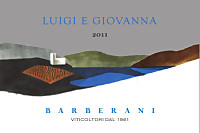
|
|
Orvieto Classico Superiore Luigi e Giovanna 2011 |
|
| Barberani (Umbria, Italy) | |
 Grechetto (90%), Procanico (10%) Grechetto (90%), Procanico (10%) | |
| Price: € 35.00 | Score: |
 Brilliant straw yellow and nuances of straw yellow, very transparent. Brilliant straw yellow and nuances of straw yellow, very transparent. Intense, clean, pleasing, refined and elegant, starts with hints of
apple, honey and plum followed by aromas of hawthorn, pear jam, broom,
citrus fruits, mature peach, hazelnut and mineral. Intense, clean, pleasing, refined and elegant, starts with hints of
apple, honey and plum followed by aromas of hawthorn, pear jam, broom,
citrus fruits, mature peach, hazelnut and mineral.
 Crisp attack and however balanced by alcohol, good body, intense
flavors, pleasing roundness. Crisp attack and however balanced by alcohol, good body, intense
flavors, pleasing roundness.
 Persistent finish with flavors of apple, plum and honey. Persistent finish with flavors of apple, plum and honey. 6 months in cask. 6 months in cask. |
|
 Stuffed pasta, Roasted white meat, Roasted fish, Mushroom soups Stuffed pasta, Roasted white meat, Roasted fish, Mushroom soups |
|
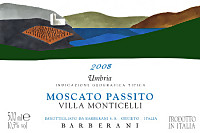
|
|
Moscato Passito Villa Monticelli 2009 |
|
| Barberani (Umbria, Italy) | |
 Muscat Blanc Muscat Blanc | |
| Price: € 38.00 - 500ml | Score: |
 Brilliant amber yellow and nuances of amber yellow, moderate
transparency. Brilliant amber yellow and nuances of amber yellow, moderate
transparency.
 Intense, clean, pleasing, refined and elegant, starts with hints of
raisin, dried fig and citrus fruit peel followed by aromas of dried
apricot, peach jam, honey, cedar, candied fruit, lavender, thyme, sage and
nail polish. Intense, clean, pleasing, refined and elegant, starts with hints of
raisin, dried fig and citrus fruit peel followed by aromas of dried
apricot, peach jam, honey, cedar, candied fruit, lavender, thyme, sage and
nail polish.
 Sweet attack and however balanced, good body, intense flavors, pleasing
crispness. Sweet attack and however balanced, good body, intense flavors, pleasing
crispness.
 Persistent finish with flavors of raisin, dried fig and dried apricot. Persistent finish with flavors of raisin, dried fig and dried apricot. Aged in steel tanks. Aged in steel tanks. |
|
 Confectionery, Jam tarts, Hard cheese Confectionery, Jam tarts, Hard cheese |
|
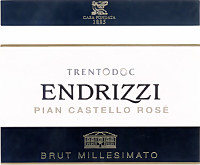
|
|
Trento Rosè Brut Pian Castello 2008 |
|
| Endrizzi (Trentino, Italy) | |
 Pinot Noir Pinot Noir | |
| Price: € 17.90 | Score: |
 Brilliant salmon pink and nuances of salmon pink, transparent, fine and
persistent perlage. Brilliant salmon pink and nuances of salmon pink, transparent, fine and
persistent perlage.
 Intense, clean, pleasing, refined and elegant, starts with hints of
cherry, raspberry and blueberry followed by aromas of strawberry, bread
crust, cyclamen, apple, yeast, plum, citrus fruits and vanilla. Intense, clean, pleasing, refined and elegant, starts with hints of
cherry, raspberry and blueberry followed by aromas of strawberry, bread
crust, cyclamen, apple, yeast, plum, citrus fruits and vanilla.
 Effervescent and crisp attack, however balanced by alcohol, good body,
intense flavors, agreeable. Effervescent and crisp attack, however balanced by alcohol, good body,
intense flavors, agreeable.
 Persistent finish with flavors of cherry, raspberry and strawberry. Persistent finish with flavors of cherry, raspberry and strawberry. Refermented in bottle on its lees for 60 months. Refermented in bottle on its lees for 60 months. |
|
 Stuffed pasta, Roasted white meat, Roasted fish, Mushroom soups Stuffed pasta, Roasted white meat, Roasted fish, Mushroom soups |
|
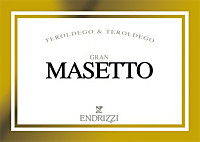
|
|
Gran Masetto 2010 |
|
| Endrizzi (Trentino, Italy) | |
 Teroldego Teroldego | |
| Price: € 37.00 | Score: |
 Deep ruby red and nuances of ruby red, impenetrable to light. Deep ruby red and nuances of ruby red, impenetrable to light. Intense, clean, pleasing, refined and elegant, starts with hints of
black cherry, blackberry and plum followed by aromas of violet, blueberry,
dried rose, vanilla, chocolate, mace, cinnamon, tobacco and menthol. Intense, clean, pleasing, refined and elegant, starts with hints of
black cherry, blackberry and plum followed by aromas of violet, blueberry,
dried rose, vanilla, chocolate, mace, cinnamon, tobacco and menthol.
 Tannic attack and however balanced by alcohol, full body, intense
flavors, pleasing roundness. Tannic attack and however balanced by alcohol, full body, intense
flavors, pleasing roundness.
 Very persistent finish with long flavors of black cherry, blackberry
and plum. Very persistent finish with long flavors of black cherry, blackberry
and plum.
 Produced with partially dried grapes. 20 months in barrique, 6 months
in bottle. Produced with partially dried grapes. 20 months in barrique, 6 months
in bottle.
|
|
 Game, Roasted meat, Stewed and braised meat, Hard cheese Game, Roasted meat, Stewed and braised meat, Hard cheese |
|
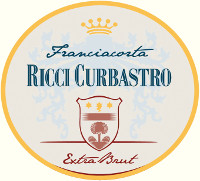
|
|
Franciacorta Extra Brut 2010 |
|
| Ricci Curbastro (Lombardy, Italy) | |
 Chardonnay (50%), Pinot Noir (50%) Chardonnay (50%), Pinot Noir (50%) | |
| Price: € 22.00 | Score: |
 Pale straw yellow and nuances of straw yellow, very transparent, fine
and persistent perlage. Pale straw yellow and nuances of straw yellow, very transparent, fine
and persistent perlage.
 Intense, clean, pleasing, refined and elegant, starts with hints of
apple, banana and plum followed by aromas of bread crust, hawthorn, yeast,
praline, grapefruit, tangerine, acacia and butter. Intense, clean, pleasing, refined and elegant, starts with hints of
apple, banana and plum followed by aromas of bread crust, hawthorn, yeast,
praline, grapefruit, tangerine, acacia and butter.
 Effervescent and crisp attack, however balanced by alcohol, good body,
intense flavors, agreeable. Effervescent and crisp attack, however balanced by alcohol, good body,
intense flavors, agreeable.
 Persistent finish with flavors of apple, grapefruit and plum. Persistent finish with flavors of apple, grapefruit and plum. Referments in bottle on its lees for 42 months. Referments in bottle on its lees for 42 months. |
|
 Roasted fish, Roasted white meat, Stuffed pasta, Fried fish, Broiled crustaceans Roasted fish, Roasted white meat, Stuffed pasta, Fried fish, Broiled crustaceans |
|
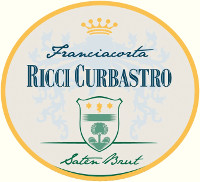
|
|
Franciacorta Satèn Brut 2010 |
|
| Ricci Curbastro (Lombardy, Italy) | |
 Chardonnay Chardonnay | |
| Price: € 22.00 | Score: |
 Pale straw yellow and nuances of straw yellow, very transparent, fine
and persistent perlage. Pale straw yellow and nuances of straw yellow, very transparent, fine
and persistent perlage.
 Intense, clean, pleasing, refined and elegant, starts with hints of
banana, apple and bread crust followed by aromas of hawthorn, citrus
fruits, plum, honey, grapefruit, praline, butter, yeast and vanilla. Intense, clean, pleasing, refined and elegant, starts with hints of
banana, apple and bread crust followed by aromas of hawthorn, citrus
fruits, plum, honey, grapefruit, praline, butter, yeast and vanilla.
 Effervescent and crisp attack, however balanced by alcohol, good body,
intense flavors, agreeable. Effervescent and crisp attack, however balanced by alcohol, good body,
intense flavors, agreeable.
 Persistent finish with flavors of apple, banana and hazelnut. Persistent finish with flavors of apple, banana and hazelnut. Refermentation in bottle and aged on its lees for about 40 months. Refermentation in bottle and aged on its lees for about 40 months. |
|
 Pasta and risotto with fish and crustaceans, Sauteed white meat, Sauteed crustaceans, Roasted fish Pasta and risotto with fish and crustaceans, Sauteed white meat, Sauteed crustaceans, Roasted fish |
|
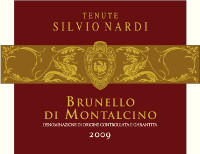
|
|
Brunello di Montalcino 2009 |
|
| Tenute Silvio Nardi (Tuscany, Italy) | |
 Sangiovese Sangiovese | |
| Price: € 28.00 | Score: |
 Brilliant ruby red and nuances of garnet red, moderate transparency. Brilliant ruby red and nuances of garnet red, moderate transparency. Intense, clean, pleasing, refined and elegant, starts with hints of
black cherry, plum and violet followed by aromas of blueberry, raspberry,
dried rose, vanilla, cinnamon, tobacco, chocolate, mace and menthol. Intense, clean, pleasing, refined and elegant, starts with hints of
black cherry, plum and violet followed by aromas of blueberry, raspberry,
dried rose, vanilla, cinnamon, tobacco, chocolate, mace and menthol.
 Tannic attack and however balanced by alcohol, good body, intense
flavors, agreeable. Tannic attack and however balanced by alcohol, good body, intense
flavors, agreeable.
 Persistent finish with flavors of black cherry, plum and raspberry. Persistent finish with flavors of black cherry, plum and raspberry. 12 months in barrique, 12 months in cask, at least 6 months in bottle. 12 months in barrique, 12 months in cask, at least 6 months in bottle. |
|
 Game, Roasted meat, Stewed and braised meat, Hard cheese Game, Roasted meat, Stewed and braised meat, Hard cheese |
|
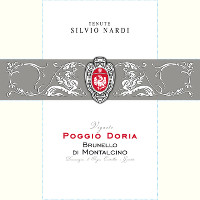
|
|
Brunello di Montalcino Vigneto Poggio Doria 2007 |
|
| Tenute Silvio Nardi (Tuscany, Italy) | |
 Sangiovese Sangiovese | |
| Price: € 80.00 | Score: |
 Brilliant ruby red and nuances of brick red, moderate transparency. Brilliant ruby red and nuances of brick red, moderate transparency. Intense, clean, pleasing, refined and elegant, starts with hints of
black cherry, raspberry and plum followed by aromas of violet, blueberry,
pink pepper, dried rose, chocolate, tobacco, cinnamon, vanilla, mace and
menthol. Intense, clean, pleasing, refined and elegant, starts with hints of
black cherry, raspberry and plum followed by aromas of violet, blueberry,
pink pepper, dried rose, chocolate, tobacco, cinnamon, vanilla, mace and
menthol.
 Tannic attack and however balanced by alcohol, full body, intense
flavors, pleasing crispness. Tannic attack and however balanced by alcohol, full body, intense
flavors, pleasing crispness.
 Very persistent finish with long flavors of black cherry, raspberry and
plum. Very persistent finish with long flavors of black cherry, raspberry and
plum.
 18 months in barrique, 12 months in cask, at least 36 months in bottle. 18 months in barrique, 12 months in cask, at least 36 months in bottle. |
|
 Game, Roasted meat, Stewed and braised meat, Hard cheese Game, Roasted meat, Stewed and braised meat, Hard cheese |
|
News |
|
In this section are published news and information about events concerning the world of wine and food. Whoever is interested in publishing this kind of information can send us a mail to our address.
|
AquavitaeReview of Grappa, Distillates and Brandy |
|
|
| Distillates are rated according to DiWineTaste's evaluation method. Please see score legend in the "Wines of the Month" section. |

|
|
Cuore di Albicocche |
|
| Nannoni (Tuscany, Italy) | |
 Pitted Apricots Pitted Apricots | |
| Price: € 25.00 - 35cl | Score: |
 Colorless, limpid and crystalline. Colorless, limpid and crystalline. Intense, clean, pleasing, refined and elegant with aromas of apricot,
honey and hazelnut, almost imperceptible alcohol pungency. Intense, clean, pleasing, refined and elegant with aromas of apricot,
honey and hazelnut, almost imperceptible alcohol pungency.
 Intense flavors and perceptible alcohol pungency which tends to
dissolve rapidly, very good correspondence to the nose, pleasing roundness,
balanced sweetness. Intense flavors and perceptible alcohol pungency which tends to
dissolve rapidly, very good correspondence to the nose, pleasing roundness,
balanced sweetness.
 Persistent finish with long flavors of apricot and honey. Persistent finish with long flavors of apricot and honey. Distilled in a batch steam operated alembic still. Product made by
Distilleria Nannoni and commercialized with its own label by "Villani Enrico". Distilled in a batch steam operated alembic still. Product made by
Distilleria Nannoni and commercialized with its own label by "Villani Enrico".
|
|
Wine Parade |
|
|
| The best 15 wines according to DiWineTaste's readers. To express your best three wines send us an E-mail or fill in the form available at our WEB site. |
| Rank | Wine, Producer | |
|---|---|---|
| 1 |
| Sagrantino di Montefalco Collepiano 2007, Arnaldo Caprai |
| 2 |
| Pelago 2009, Umani Ronchi |
| 3 |
| Villa Gresti 2006, Tenuta San Leonardo |
| 4 |
| I Sodi di San Niccolò 2008, Castellare di Castellina |
| 5 |
| Amarone della Valpolicella Classico Capitel Monte Olmi 2007, Tedeschi |
| 6 |
| Adarmando 2011, Tabarrini |
| 7 |
| Collio Ribolla Gialla L'Adelchi 2012, Venica |
| 8 |
| Montiano 2011, Falesco |
| 9 |
| Brunello di Montalcino Montosoli 2009, Altesino |
| 10 |
| Brunello di Montalcino Vigna Loreto 2007, Mastrojanni |
| 11 |
| Torgiano Rosso Riserva Rubesco Vigna Monticchio 2007, Lungarotti |
| 12 |
| Maximo 2010, Umani Ronchi |
| 13 |
| Langhe Riesling Herzu 2011, Ettore Germano |
| 14 |
| Verdicchio dei Castelli di Jesi Classico Superiore Podium 2010, Garofoli |
| 15 |
| Brunello di Montalcino 2007, Donatella Cinelli Colombini |
| |||||||
Privacy Policy | |||||||


| Copyright © 2002-2024 Antonello Biancalana, DiWineTaste - All rights reserved |
| All rights reserved under international copyright conventions. No part of this publication and of this WEB site may be
reproduced or utilized in any form or by any means, electronic or mechanical, without permission in writing from DiWineTaste. |